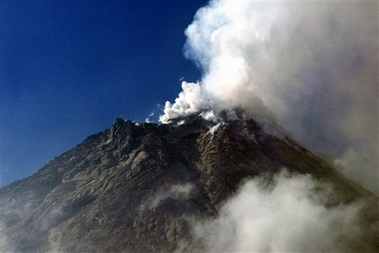Large eruptions of searing hot gas and debris forced
more than 1,000 villagers to flee Mount Merapi's slopes Wednesday, and
authorities raised the volcano's alert level to its highest status again, just a
day after they let people go back home.

Mount Merapi spews hot clouds of gas and ash
seen from Babadan village outside Yogyakarta, Indonesia, Wednesday, June
14, 2006. [AP] |
A gas cloud nearly enveloped one village, and ash covered another village
that was 4 1/2 miles from the crater with a gray blanket an inch thick,
officials said. Up to 20,000 people are living in the mandatory evacuation zone.
The alert level was dropped a notch Tuesday, sparking widespread relief for
people who have spent weeks in evacuation camps. That relief quickly turned to
concern Wednesday.
"We were very happy to go back in the morning but as soon as we got there we
saw a massive cloud steaming toward us," Egan said after being trucked back to
the camp. "We all decided it was time to leave."
Mount Merapi, one of Indonesia's most dangerous and unpredictable volcanoes,
has been venting massive clouds of hot gas and debris and sending lava flows
streaming down its slopes for more than a month.
Activity had slowed in recent days, allowing villagers to return home. They
were told to stay alert, and evacuation trucks remained on standby in each
village.
"When we downgraded the status, we said that if its activities increased and
we thought it was dangerous to the people, then we will review it," government
scientist Subandrio told el-Shinta radio station when he announced the alert
status had been raised again.
Wednesday's deadly gas clouds rolled more than three miles down the slope and
nearly enveloped one village, said Triyani, another government scientist who
also goes by a single name.
Some 12,000 in seven villages in the Magelang district, on the mountain's
west side, were ordered to leave, said district official Edy Susanto. Some were
awaiting trucks to take them to shelters as dusk fell.
"The villagers are confused. They said it was safe, but hot clouds
re-emerged. One thing for sure, we have readied ourselves to evacuate anytime,"
said Budiono, the chief of Ngargosoko, a village six miles from the peak that
was ordered evacuated.
Despite the danger, many people have stayed put in the last month, citing the
need to look after homes, crops and animals.
The main dangers at the 9,700-foot Merapi are fast-moving bursts of
blistering gases and rock fragments called pyroclastic flow.
One killed more than 60 villagers in 1994, and about 1,300 people died when
Merapi erupted in 1930.